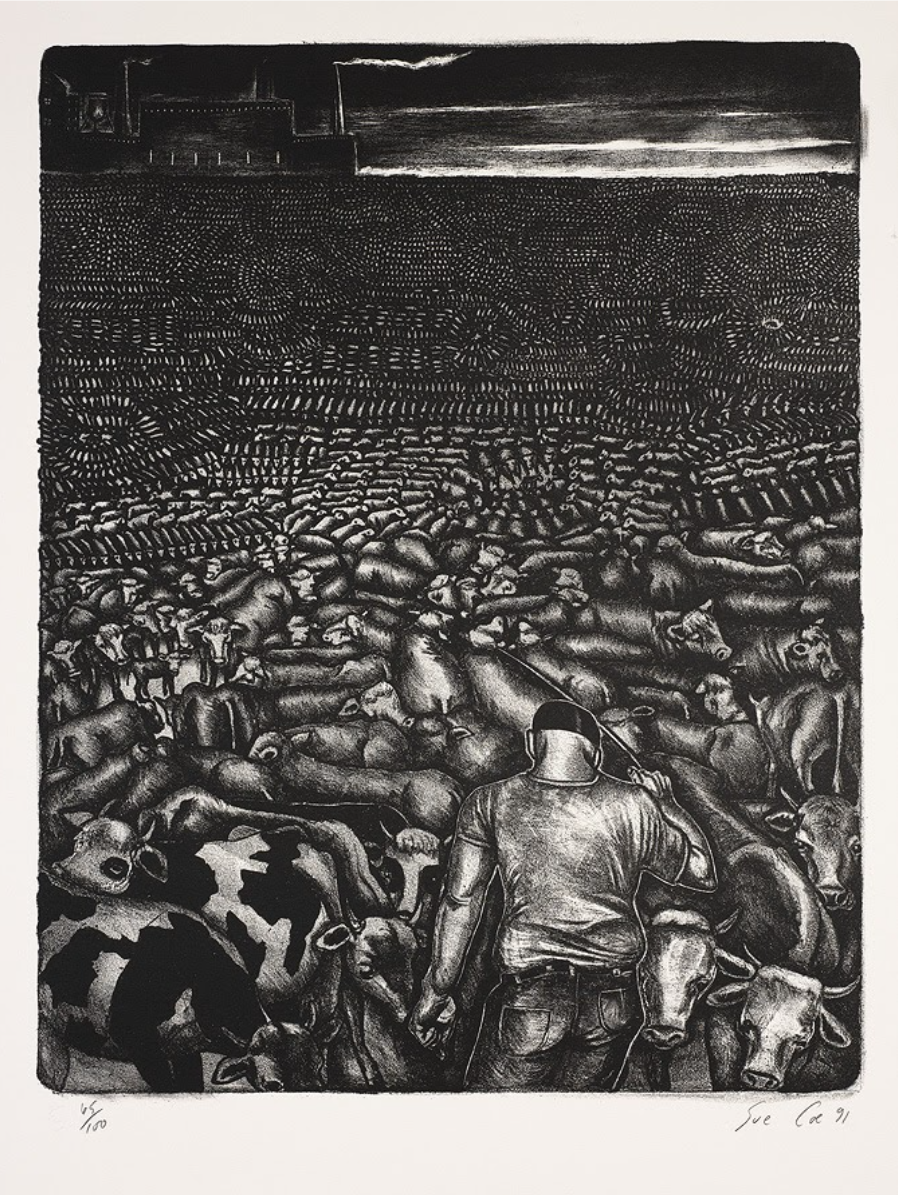
Sue Coe, English, 1951-. Feed Lot, 1991. Print, lithograph printed in black on wove paper. Gift of Sue Coe. SMITH COLLEGE MUSEUM OF ART. SC 2006.4.2
- Feed Lot, by artist and animal rights activist Sue Coe, depicts a seemingly endless crowd of cattle clustered in front of a single farmer. A factory spewing smoke looms in the back left corner, giving way to a gloomy sky. The print is part of a series called Porkopolis, which exposes the brutalities of slaughterhouses and the meat industry.
How is this related to climate?
- Feed Lot speaks indirectly to the climate crisis. Cows and other livestock with four-chambered stomachs emit high levels of methane, a powerful greenhouse gas that is released through natural processes, such as decomposition and microbial respiration, and by man-made sources, such as oil and gas drilling. There are 1.4 billion cattle in the world, accounting for about 40% of annual methane emissions. Livestock industries as a whole are responsible for more than 14% of annual anthropogenic greenhouse gas emissions.
- Upon their entry into the atmosphere, greenhouse gases trap in heat from the sun. Though greenhouse gases, including methane, occur naturally and help regulate Earth’s temperature, extremely high amounts can trap too much heat, resulting in global warming.
- Methane is much less abundant in the atmosphere than carbon dioxide, with concentrations around 1,800 parts per billion compared to around 400 parts per million of carbon dioxide, but its molecular structure makes it much more efficient at trapping heat. It has 28 times the warming potential of carbon dioxide and is responsible for 20% of global warming. Therefore, adding a little bit of methane to the atmosphere can have big impacts on how much and how quickly the planet warms.
Further Exploration
- Cows infected with diseases tend to produce more methane than healthy cows. For example, methane emissions from livestock are projected to increase by 20% from 2017 to 2050 but when parasitic worm infections are taken into consideration, this number could be as high as 80%. As a result, a positive feedback loop is established between livestock, parasitic worms and global temperatures. Parasitic worms cause livestock to produce more methane, raising global temperatures, which encourages the growth of more parasitic worms.
References and additional resources
- Borunda, A. “Methane, Explained.” National Geographic. 2019. https://www.nationalgeographic.com/environment/article/methane.
- Calma, J. “Climate change has a cow and worm problem.” The Verge. 2020. https://www.theverge.com/21505736/climate-change-cattle-livestock-infectious-disease-methane.
- Rowlatt, J. “Cutting methane gas ‘crucial for climate fight.’” BBC News. 2021. https://www.bbc.com/news/science-environment-56933443.
- Singer, J. “New Video: ‘Sue Coe: Art of The Animal.’” Our Hen House. 2011. https://www.ourhenhouse.org/2011/12/new-video-sue-coe-art-of-the-animal/.
- “The Greenhouse Effect.” Ucar Center for Science and Education. n.d. https://scied.ucar.edu/learning-zone/how-climate-works/greenhouse-effect.
